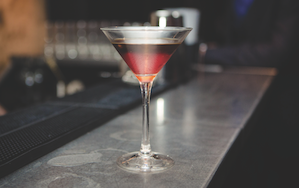The author, who remains anonymous, of Cocktails: How To Make Them, published in 1898, stated that: “The addition of vermouth was the first move toward the blending of cocktails.” In his book, Imbibe, David Wondrich considers that, while the Martini became the standard-bearer of this early movement “it was the Manhattan that was the first out of the trenches”.
It’s not surprising that the advent of vermouth in the US around the mid-19th century led to other spirituous additions – imagine how boring just having a vermouth on the rocks with a slice would be? Enter gin, Cognac and whisky, all adding a certain spice – not to say a much-needed alcoholic boost – to a drink.
In terms of cocktails, arguably the Manhattan is to whisky what the Martini is to gin and when it comes to whisky cocktails it is on a pedestal on its own. While its place of birth is not in doubt, much like the Martini its inception is shrouded in stories which are largely apocryphal. It was also known as The Turf Club Cocktail and the Jockey Club – but today this ingenious mix of whisky, bitters and sweet vermouth is simply known as the Manhattan. Interestingly too the vast majority of recipes from the pre-Prohibition era do not specify the type of whisky to use, and these days it’s very much up to the consumer.
As Wondrich notes in his book: “As much of a rye partisan as I am, I’ve nonetheless found that the choice of rye or bourbon is less important than the choice of 80 or 100 proof whiskey.” In short, the stronger the better, so no surprises then that it’s good with Scotch, which has more of a weather-beaten taste generally than the sweeter, fruitier-tasting American whiskeys.
As far as William Grant is concerned, at any rate, its Scotch whisky Monkey Shoulder – a triple-blended malt – is perfect for the Manhattan, as well as the other classic whisky cocktails, the Rob Roy and, of course, the Old Fashioned.
Indeed, at key musical events around the UK, the Monkey Trike (an electric tricycle, pictured below) is ever-present, dispensing Old Fashions, dispelling at a stroke all preconceptions about whether Scotch should be used in cocktails.
“Our mission is to bring folk into Scotch and there’s two sides to that coin – attracting new folk to Scotch and Scotch drinking folk to cocktails,” says the company’s brand ambassador, James O’Connor. “There’s a lot of snobbishness when it comes to Scotch, even mixing it with cola – and that’s a really good taste combination.”
Cocktail guru and trainer Wayne Collins, Mixxit – global manager at Maxxium UK – maintains that Scotch whisky is the most challenging spirit in terms of making cocktails. “You’ve got be a bit clever and to really know Scotch whisky, your malts as well as your blends – for instance if you try to make a Rob Roy with an Islay you have a train wreck on your hands, as the smokiness is overpowering. But using the likes of the Famous Grouse it’s fantastic.”




